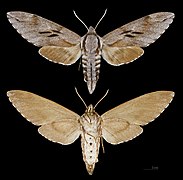Sphinx (genus)
| sphinx | ||||||||||
|---|---|---|---|---|---|---|---|---|---|---|

Pine hawk ( Sphinx pinastri ) |
||||||||||
| Systematics | ||||||||||
|
||||||||||
| Scientific name | ||||||||||
| sphinx | ||||||||||
| Linnaeus , 1758 |

Sphinx is a genus within the butterfly family of swarmers (Sphingidae). The species of the genus occur mainly in America , especially in the Nearctic , but some species also live in the Palearctic .
features
The hind wings of the moths have two dark bands near the outer edge. The proboscis is roughly the same length as the body. The antennae are equally thick in both sexes and have only a very weak hook at the tip. The compound eyes are small and ciliate. The abdomen is gray, white, pink or yellow in color and has black cross bars. The tibiae of the hind legs have two pairs of spurs, the pair closer to the body being significantly longer than the second. The genus differs from other swarm genera by the tibia of the forelegs covered with spurs and by the absence of pulvilli on the tarsi .
The eggs are round and pale green in color.
The almost round head of the caterpillars is slightly narrowed at the top. The body has a cylindrical cross section. Its color usually consists of a shade of green and has seven oblique stripes on the side, which are either white or white in combination with a dark color. In the last stage of the caterpillar, the surface is rarely grainy. The anal horn is erect, slightly curved, and shiny in the last stage.
The pupae are shiny red-brown and have a small proboscis sheath separated from the body.
Way of life
The caterpillars feed on many different plant families, but prefer bushes and trees of the olive family (Oleaceae), rose family (Rosaceae), honeysuckle family (Caprifoliaceae), heather family (Ericaceae) and mint family (Lamiaceae). Some species also feed on the cypress family (Cupressaceae) and pine family (Pinaceae).
Systematics
For a long time the genus Lintneria , which was originally first described by Arthur Gardiner Butler in 1876, was considered a synonym of Sphinx , as in "Hawkmoths of the World. An Annotated and Illustrated Revisionary Checklist (Lepidoptera: Sphingidae)", the comprehensive list of species of the family of Kitching & Cadiou from 2000, although William Trowbridge Merrifield Forbes correctly recognized as early as 1911 that the genus should be separated from Sphinx due to the morphology of the caterpillars . In 2007 the genus was finally reintroduced by James P. Tuttle and 21 species were spun off from the genus Sphinx . This was finally confirmed in a molecular genetic study.
In Europe the genus Sphinx is only represented by three species, two of which are also native to Central Europe. Worldwide 31 species are assigned to the genus:
- Sphinx adumbrata (Dyar, 1912)
- Sphinx asellus ( Rothschild & Jordan , 1903)
- Sphinx bhutana Brechlin, 2015
- Sphinx caligineus (Butler, 1877)
- Sphinx canadensis Boisduval, 1875
- Sphinx centrosinaria Kitching & Jin, 1998
- Sphinx centrovietnama Brechlin, 2015
- Sphinx chersis (Huebner, 1823)
- Sphinx chisoya (Schaus, 1932)
- Sphinx constricta Butler, 1885
- Sphinx crassistriga (Rothschild & Jordan, 1903)
- Sphinx dollii Neumoegen, 1881
- Sphinx drupiferarum JE Smith, 1797
- Sphinx formosana Riotte, 1970
- Sphinx franckii Neumoegen, 1893
- Sphinx gordius Cramer, 1779
- Sphinx kalmiae JE Smith, 1797
- Sphinx leucophaeata Clemens, 1859
- Sphinx libocedrus Edwards, 1881
- Privet hawk ( Sphinx ligustri ) Linnaeus, 1758 A, CH, D
- Sphinx luscitiosa Clemens, 1859
- Sphinx maurorum (Jordan, 1931) Europe
- Sphinx morio (Rothschild & Jordan, 1903)
- Sphinx nogueirai Haxaire, 2002
- Sphinx oberthueri (Rothschild & Jordan, 1903)
- Sphinx perelegans Edwards, 1874
- Pine hawks , or fir arrow ( Sphinx pinastri ) Linnaeus, 1758 A, CH, D
- Sphinx poecila Stephens, 1828
- Sphinx sequoiae Boisduval, 1868
- Sphinx vashti Strecker, 1878
- Sphinx yunnana Brechlin, 2015
supporting documents
Individual evidence
- ↑ a b c d e Sphingidae of the Western Palaearctic. AR Pittaway, accessed April 26, 2008 .
- ^ Ian J. Kitching, Jean-Marie Cadiou: Hawkmoths of the World. An Annotated and Illustrated Revisionary Checklist (Lepidoptera: Sphingidae). Cornell University Press, New York 2000, ISBN 0-8014-3734-2
- ↑ a b James P. Tuttle: The Hawkmoths of North America, A Natural History Study of the Sphingidae of the United States and Canada. The Wedge Entomological Research Foundation, Washington, DC 2007, ISBN 978-0-9796633-0-7
- ↑ Akito Y. Kawahara, Andre A. Mignault, Jerome C. Regier, Ian J. Kitching, Charles Mitter: Phylogeny and Biogeography of Hawkmoths (Lepidoptera: Sphingidae): Evidence from Five Nuclear Genes. PLoS ONE 4 (5): e5719. doi: 10.1371 / journal.pone.0005719 .
- ↑ Sphinx. Fauna Europaea, accessed January 6, 2012 .
- ↑ Sphinx Linnaeus, 1758. Sphingidae Taxonomic Inventory, accessed June 29, 2015 .
literature
- Hans-Josef Weidemann, Jochen Köhler: Moths, Spinners and Swarmers. Naturbuch-Verlag, Augsburg 1996, ISBN 3-89440-128-1 .
- AR Pittaway: The Hawkmoths of the western Palaearctic. Harley Books 1993, ISBN 0-946589-21-6 .
- Manfred Koch : We determine butterflies. Volume 2: Bears, Spinners, Swarmers and Drills in Germany. 2nd, expanded edition. Neumann, Radebeul / Berlin 1964, DNB 452481929 .
- R. Reinhard, K. Harz: Wandering swarmers. Die Neue Brehm Bücherei, Volume 596, Spektrum Akademischer Verlag, 2nd unaltered edition, 1996, ISBN 3-89432-859-2 .






